View in other NatureServe Network Field Guides
NatureServe
Montana
Utah
Wyoming
Idaho
Wisconsin
British Columbia
South Carolina
Yukon
California
New York
Ovate Vertigo Snail - Vertigo ovata
Other Names:
Pupa ovata
General Description
A small snail, to about 1.4 mm diameter and 2.5 mm in height, subovate (pupiform) and tapering, nearly smooth with fine incremental striae, about 5 whorls. Shell coloration is translucent reddish-brown. Aperture subovate, with nine teeth (denticles: angular, parietal, infraparietal, columellar, subcolumellar, suprapalatal, upper palatal, lower palatal, infrapalatal), palatal callus heavy, crest large, sinulus deep and sharply inward pointing, lip thin and flared outward (Hendricks 2012, Burke 2013).
The subspecies in Montana is Vertigo ovata ovata.
Diagnostic Characteristics
Combination of size (height < 3.0 mm) and shape, presence of teeth in a subovate aperture, 4-5 whorls, and an indentation in palatal lip distinguish Vertigo from similar appearing shells. A sinulus strongly indented in the aperture with a heavy palatal callus and 9 teeth in aperture distinguishes this species from all others.
Species Range
Montana Range
Range Descriptions
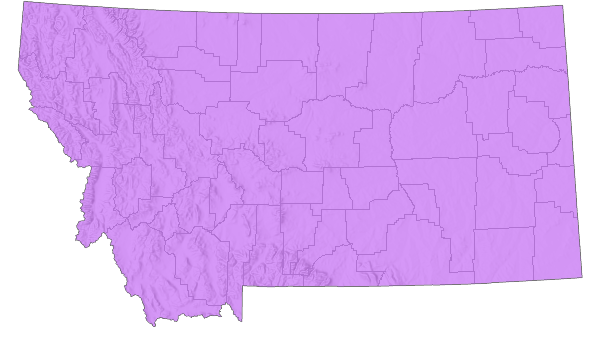
 Native
Native
Range Comments
Alaska to Labrador, south to Florida, west to California and Mexico. In Montana, reported on both sides of the Continental Divide from seven counties: Flathead, Lake, Lewis and Clark, Lincoln, Ravalli, Wheatland, Wibaux. Elevation range is 823 to 1468 m (2700 to 4815 ft). Range and abundance in Montana are poorly defined; current status needs investigation. Spotty distribution and marshland habitat indicate possible dispersal via waterfowl. May be common locally; 13 were reported at one Lincoln County site in early October (Hendricks 2012).
Observations in Montana Natural Heritage Program Database
Number of Observations: 18
(Click on the following maps and charts to see full sized version)
Map Help and Descriptions
Relative Density

Recency
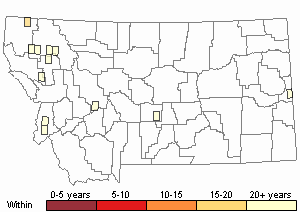
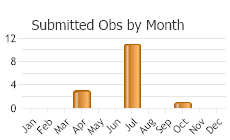
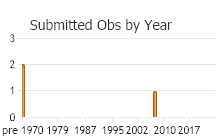
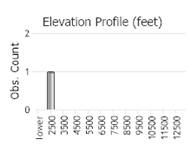 (Observations spanning multiple months or years are excluded from time charts)
(Observations spanning multiple months or years are excluded from time charts)
Habitat
Edges of marshes, ponds, waterways, in both forested and open sites. Canopy tree species include Engelmann spruce, lodgepole pine, aspen, plains cottonwood, alder, and willow. Found under woody debris, decaying vegetation, leaf litter (Hendricks 2012).
Stewardship Responsibility
References
- Literature Cited AboveLegend:
 View Online Publication
View Online Publication Burke, T. E. 2013. Land snails and slugs of the Pacific Northwest. Corvallis, OR: Oregon State University Press. 344 p.
Burke, T. E. 2013. Land snails and slugs of the Pacific Northwest. Corvallis, OR: Oregon State University Press. 344 p. Hendricks, P. 2012. A Guide to the Land Snails and Slugs of Montana. A report to the U.S. Forest Service - Region 1. Montana Natural Heritage Program, Helena, MT. vii + 187 pp. plus appendices.
Hendricks, P. 2012. A Guide to the Land Snails and Slugs of Montana. A report to the U.S. Forest Service - Region 1. Montana Natural Heritage Program, Helena, MT. vii + 187 pp. plus appendices.
- Additional ReferencesLegend:
 View Online Publication
View Online Publication
Do you know of a citation we're missing? Berry, S.S. 1916. Notes of Mollusca of central Montana. Nautilus 29:124-128.
Berry, S.S. 1916. Notes of Mollusca of central Montana. Nautilus 29:124-128. Forsyth, R.G. 2004. Land snails of British Columbia. Royal British Columbia Museum: Victoria, British Columbia, Canada. 188 pp.
Forsyth, R.G. 2004. Land snails of British Columbia. Royal British Columbia Museum: Victoria, British Columbia, Canada. 188 pp. Frest, T.J. and E.J. Johannes. 2001. An annotated checklist of Idaho land and freshwater mollusks. Journal of the Idaho Academy of Science 36(2):1-51.
Frest, T.J. and E.J. Johannes. 2001. An annotated checklist of Idaho land and freshwater mollusks. Journal of the Idaho Academy of Science 36(2):1-51. Pilsbry, H.A. 1948. Land Mollusca of North America (north of Mexico), Volume II Part 2. The Academy of Natural Sciences of Philadelphia Monograph Number 2(2): 521-1113.
Pilsbry, H.A. 1948. Land Mollusca of North America (north of Mexico), Volume II Part 2. The Academy of Natural Sciences of Philadelphia Monograph Number 2(2): 521-1113. Squyer, H. 1894. List of shells from the vicinity of Mingusville, Montana. The Nautilus 8:63-65.
Squyer, H. 1894. List of shells from the vicinity of Mingusville, Montana. The Nautilus 8:63-65. Vanatta, E.G. 1914. Montana shells. Proceedings of the Academy of Natural Sciences of Philadelphia 66:367-371.
Vanatta, E.G. 1914. Montana shells. Proceedings of the Academy of Natural Sciences of Philadelphia 66:367-371.
- Web Search Engines for Articles on "Ovate Vertigo Snail"
- Additional Sources of Information Related to "Snails / Slugs"





